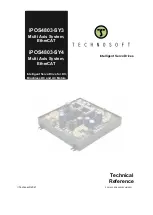
4 - 47
4 System Design
G5-series Linear Motors/Servo Drives With Built-in EtherCAT Communications
4-5 R
egen
erative En
ergy Ab
sorp
tion
4
4-
5-1 C
alculating
the Regene
rative Ener
gy
4-5
Regenerative Energy Absorption
A Servo Drive uses its built-in capacitors to absorb the regenerative energy produced during Linear
Motor deceleration. If the amount of regenerative energy is too much for the built-in capacitors to
absorb, it also uses an Internal Regeneration Resistor. An overvoltage error occurs, however, if the
amount of regenerative energy from the Linear Motor is too large. If this occurs, reduce the regenerative
energy by changing operating patterns or increase the regeneration process capacity by connecting
External Regeneration Units.
Additional Information
•
Some Servo Drive models may not have any built-in Internal Regeneration Resistor.
•
The regeneration absorption capacity of a Servo Drive varies depending on the drive model.
For information on whether or not your Servo Drive has an Internal Regeneration Resistor and its
regeneration absorption capacity, refer to 4-5-2 Servo Drive Regeneration Absorption Capacity
on page 4-49.
This section describes how to calculate the regenerative energy for the horizontal axis.
In the output force graph, acceleration in a positive direction is shown as positive (+), and acceleration
in a negative direction is shown as negative (–).
The regenerative energy values in each region can be derived from the following equations.
Note
Due to the loss caused by the motor winding resistance and the sliding friction, the actual regenerative
energy will be approximately 90% of the values derived from these equations.
4-5-1
Calculating the Regenerative Energy
+V
1
- V
2
F
D1
F
D2
t
1
t
2
T
E
g1
E
g2
Motor operation
Motor output force
V
1
V
2
F
D1
F
D2
t
1
t
2
E
g1 =
1
2
V
1
F
D1
t
[J]
1
E
g2 =
1
2
V
2
F
D1
t
[J]
2
,
,
,
: Speed of deceleration [mm/s]
: Deceleration force [N]
: Deceleration time [s]
















































